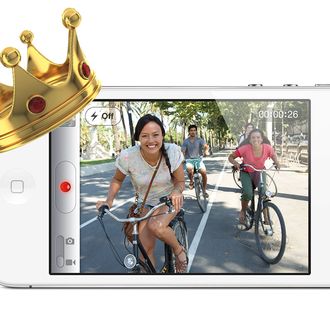
Last week, a San Jose jury did what ten years of Silicon Valley design meetings and engineering confabs could not: force smartphone makers to think beyond the iPhone.
As you probably know by now, that jury awarded Apple $1 billion in damages after a lengthy courtroom battle with Samsung, agreeing that Samsung violated Apple’s patents on iPhone features like the “pinch-to-zoom” effect and a rounded rectangular shape. Apple, emboldened by the verdict, is now seeking a ban on the sale of eight Samsung devices in the United States.
Apple’s victory, which could still be overturned on appeal, has already inspired a ton of hand-wringing in tech circles: Will anyone be able to make a litigation-free smartphone again? Will tech companies have to sell triangular tablets to keep from being sued?
My sympathies in tech patent disputes, when I have them, generally lie with those accused of infringement. I tend to believe that few innovations in any industry emerge sui generis, out of a single engineer’s brain, and that most are patchwork composites, some new ideas cobbled onto some old ones. (I’ve always liked Bill Gates’s storied reply to Steve Jobs, when Jobs accused Gates of stealing the graphical interface behind Windows: “Well, Steve, I think it’s more like we both had this rich neighbor named Xerox and I broke into his house to steal the TV set and found out that you had already stolen it.”)
In the matter of Apple v. Samsung, though, I found myself unexpectedly cheering for the Cupertino crew. Why?
Not because I believe that patent law, as it currently exists, works well in preventing legitimate theft while encouraging innovation. And not because I have any sympathy for Apple, a behemoth for whom a $1 billion award amounts to a rounding error.
No, I rooted for Apple because the mobile device industry has, for the better part of the last decade, amounted to a lazy, industry-wide game of catch-up. (Step one: Apple makes a groundbreaking product. Step two: Competitors spend the next six months throwing together half-baked simulacra of said Apple product. Step three: Tech reviewers deride the ways in which the knockoff gadgets depart from Apple’s ideal, while praising the ways in which the two devices are alike.) And it’s time for other smartphone makers to break the Apple-chasing cycle, for their sakes and ours.
In the tech world, there has always been a stigma around shameless copying. (Witness the Valley-wide villainization of the Samwer brothers, for example.) But when it comes to smartphones, the giants of industry have somehow gotten a pass. The iPhone and iPad are so dominant, it seems, that trying anything else would be a waste of time and cash.
There’s no doubt that being forced to stop playing the iPhone catch-up game will be hard for Samsung, Motorola, HTC, and other smartphone makers in the short term. Bill Flora, creative director at Tectonic, told the Times this weekend that the iPhone’s pinch-to-zoom function is “very much like a circular steering wheel,” in that departing from it would immediately knock an Apple competitor out of contention. And there’s little doubt, as Farhad Manjoo put it, that aping Apple has probably been good for both Samsung and the consumer smartphone market as a whole.
But in the long term, Apple’s competitors will, I predict, be sending gift baskets to the San Jose jurors. Because not only has participating in the Apple catch-up game taken up valuable time and resources that could have been used to bring truly new products to markets, but it has jeopardized their ability to remain trusted and viable companies.
What Stanford engineering major, after all, would want to spend the most creative years of his life furiously reverse-engineering FaceTime? What genius at MIT is breathlessly waiting to clone the rubber-band effect?
For Samsung, Microsoft, Nokia, and other companies to remain relevant and keep attracting top-tier talent, they’re going to have to make new products at regular intervals. They’re going to have to throw out the iPhone blueprints and come up with the smartphone equivalent of Mercedes-Benz’s concept steering stick.
If they’re not able to do that with their current staff and resources — if, as law professor Timothy Holbrook suggests in the Times piece, their product design meetings will now consist of looking at the newest Apple gadget and saying, “Let’s try to get as close as possible without infringing” — then the Apple/Samsung verdict may in fact be a death knell for some companies.
But it is possible to succeed in a post-clone world, as Microsoft has proved with what one reviewer called its “objectively beautiful” Windows Phone OS. Consumers are used to the iPhone, yes, but they were used to their Palm Pilots and DOS machines, too. There’s no barrier to new, genuinely innovative products except the complacency of smartphone design teams, and the chase after short-term profits. And Apple’s competitors, all of whom no doubt employ engineers with great ideas about how to move the smartphone forward, should be glad to be released from the endless cycle of iPhone-duplication.
By forcing Samsung’s designers to look elsewhere for inspiration, the San Jose jury has given it and other smartphone also-rans more than a $1 billion hole in the pocket.
It may, in the long run, have given them their souls back.





























